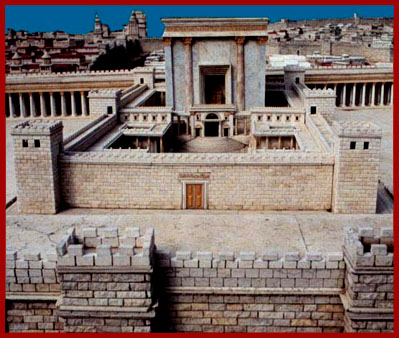 |
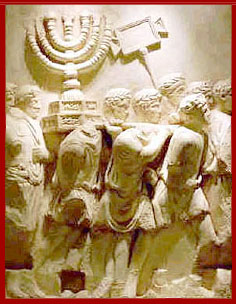 |
|
The Temple of
Herod
(Model-reconstruction) |
The Arch of Titus,
Rome, 180.
|
JEWISH
CAPTIVITY
and
REBELLIONS
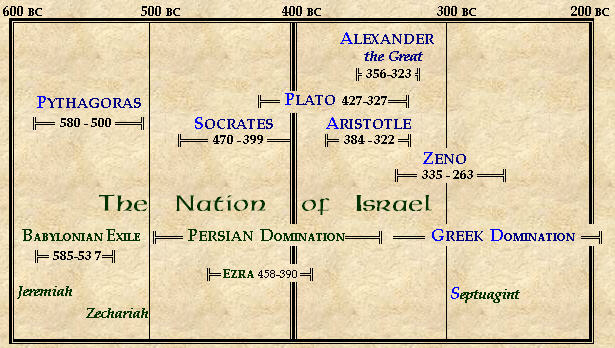 |
 |
|
AT THE
TIME of CHRIST
|
[...following a] violent anti-Jewish persecution (AD
38),. the Jews of Alexandria, In protest ,finally sent a legation to the emperor
in AD 40 to plead their cause. A noted member of it was the philosopher, Philo,
but the emissaries had little success (Ant. 18.8,
i
§ 257; Philo, Embassy to Gaius). When
Herod Antipas was exiled in 39, his territory (Galilee and Perea) was added to the domain of Herod
Agrippa
I. The latter, who had been insulted by the
Roniart prefect of Egypt, was more successful in influencing the legate of
Syria, P. Petronius, who had been sent out by Caligula in 39. King Herod urged
him not to press the issue of emperor worship; consequently, Petronius delayed
as far as Jerusalem was concerned. But when the pagan inhabitants of the coastal
town Janinia erected a crude altar to the emperor, it was torn down by the Jews
of the locale. The incident was reported to the emperor, who retaliated by
ordering the immediate erection of a colossal statue of himself in the Jerusalem
Temple (Philo, Embassy to Gaius 30 § 203). But Petronius still
procrastinated, while trying to get the Jewish leaders to accept this order with
good grace. Horrified, the Jews gathered in Ptolemais where Petronius was
quartered, and begged him not to erect the statue. Petronius wrote to Caligula,
only to bring down imperial wrath on his own head. Then Herod
Agrippa
visited Caligula in the hope of having him
rescind the order. Incensed at Petronius, the emperor commanded him to commit
suicide. However, the whole issue was resolved by the murder of Caligula on 24
January AD 41
When Claudius (41-54) came to the throne by the
acclamation of the Roman troops, his reign began with an edict of toleration in
favor of the Jews (Ant. 19.5, 2-3 § 279ff ). He rewarded Herod
Agrippa
I for his support of the Roman rule, extending
his territory to include that of the ethnarchy of Archelaus (Judea, Samaria,
Idumea), so that from then until his death he ruled over a territory almost as
vast as that of Herod the Great. Herod
Agrippa
undertook to build Jerusalem’s “third north
wall,” which, if completed, would have made the city impregnable. But before it
could be finished, Claudius who had been warned by Maurus, thelegate of Syria,
forbade any further work on it (Ant. 19.7, 2 § 326-27). [...] Herod
Agrippa
was an insignificant but pious king, whose
passing was mourned by the people, for at home he supported Pharisaism, even
though abroad he liberally advocated Hellenistic culture and contributed inuch
to the pagan institutions of Berytus [modern Beirut]. Given his support of
Pharisaism, however, it is not surprising that he persecuted the nascent Christian Church (Acts 12:1-19); one of his victims was James, the son of
Zebedee, beheaded ca. AD 44. Herod
Agrippa
died suddenly at Caesarea in AD 44, while attending the Vicennalia, games in honor of the
emperor (Acts 12:20 23 ; Ant. 19.8, 2 § 343-50)
|
Spread of the Christian Church.
|
On the death of Herod
Agrippa
I, the Emperor Claudius The primitive
Christian community became more and more conscious of its comission to
proclaim the “gospel of Jesus Christ” (Mk i:r). After some
initial success in converting Palestinian Jews (Acts 2:47; 6:7; etc.), the
apostolic preachers turned to the metropolitan centers of the Roman Empire.
Gradually the “good news” spread from Jerusalem to “the end of the earth” (Acts
1:18), addressed first of all to the Jews of the Diaspora and then to the
Gentiles.
Possibly it was in AD 36, when P.
Pilate was sent back to Rome and a new prefect Marcellus was named (36-37),
that the “great persecution of the church” (Acts 8:1) took place. The
appointment of a new governor seems to have been particularly apt for such an
outbreak. At any rate, it was in the context of a Jewish persecution of the
young Palestinian Christian community that Stephen was martyred and
Saul
of Tarsus “breathed [his] murderous threats”
(Acts 9:1-2). Saul’s conversion, which cannot be dated accurately, is plausibly
related to this time (-. Life of Paul, 46:16).
|
Herod Agrippa I (37-44).
|
The Emperor Tiberius died on 16 March AD 37. The
legate of Syria, L. Vitellius, was still in Jerusalein, trying to soothe the
feelings of the Palestinian Jews who had been outraged by Pilate, when the news
reached there of the new eniperor, Gaius Caligula (37-41). The Jews were the
first of the nationalities of Syria to pledge their allegiance to the new
emperor and hailed his regime, which was peaceful and quiet for the first 18
inonths. But whereas Tiberius had eschewed emperor worship, Caligula now began
to insist on it. He wanted images of himself as divus erected in all
shrines and temples (including synagogues) in the empire.
Caligula was not long on the imperial throne
before he conferred on his friend Herod
Agrippa
I, the brother of Herodias and the grandson of
Herod the Great, the territory of Philip’s tetrarchy in N Transjordan (-. 141
above). With this grant went the title of king. On his way back to Palestine,
King Herod stopped at Alexandria, and his brief sojourn there became the
occasion of a serious defamatory outburst against hini and against the local
once again reorganized the country into a Roman province to be ruled by
procurators. The last of the Herodian family to enjoy partial rule in the area,
however, was Marcus Julius
Agrippa
II, the son of Herod
Agrippa
I, who like most of his family had been brought
up at Rome and was a mere boy of 17 when his father died. He did not inherit his
father’s realm immediately, but when his uncle, Herod of Chalcis, died (48), he
became the ruler of this small territory on the slopes of the Antilebanon. He
subsequently relinquished this realm (ca. 52) and received from Claudius the old
tetrarchy of Philip, to which
Nero later added parts of Galilee and Perea. His relations with his sister Bernice (probably incestuous)
caused scandal in Rome (Ant.
20.7, 3 § 145; Juvenal, Sat.
6.156fî.). It was before
Agrippa and Bernice that the prisoner Paul
had to explain his case in Caesarea (Acts 25:23fî.). After the fall of
Jerusalem, Agrippa
II went to Rome and lived there with Bernice; he
was a praetor for a while and died between 93 and too. While ruling in
Palestine, he had little influence on the Jewish population; he was opposed
constantly by the priests and arbitrarily nominated and deposed high priests in
rapid succession. The end of the Herodian dynasty was not glorious.
In
this period, and more precisely in the procuratorship of Tiberius
Julius
Alexander (46-48), Judea and other parts of the
eastern Mediterranean world suffered from a severe famine. A prediction that it
would affect “the whole world” is recorded in Acts 11:28. The striken
Palestinian populace was aided by grain brought from Egypt with the help of a
Jewish convert, Queen Helen of Adiabene (Ant.
20.5, 2 § 100-101). Possibly this
famine was the occasion of the visit of Barnabas and
Saul
to Jerusalem (Acts 11:29-30; 12:25;
-> Life of Paul, 46:5, 24). It was possibly in the summer of 49-the date cannot
be determined precisely (-. Life of Paul, 46:28-34)-that the meeting of
the apostles and elders took place in Jerusalem. The Jerusalem “Council” decided
against the circumcision of Gentile Christians and their obligation to observe
the Mosaic Law (Acts 15:2-12). It was the historic decision that emancipated the
Christian Church from its Jewish origins.
The
true rulers of Palestine in this period were the procurators, who made no
attempt to understand the Jewish people, made little allowance for popular
manifestations, and rather looked for the chance to harass them. The period was
marked by a succession of minor uprisings (Ant.
20.5, 1 § 97-98; 20.5, 3 § 106-12;
HE 2.11, 2-3). The most notorious procurator of this period was M. •Antonius
Felix
(ca. 52-60), who married into the Herodian
family, becoming the second husband of Drusilla, the sister of
Agrippa
II. Under him the uprisings developed into open
hostility. He had been sent to Palestine by the emperor at the request of a
deposed high priest (Jonathan), then living at Rome. Tacitus wrote of
Felix,
“In the spirit of a slave he carried out the
royal duties with all sorts of cruelty and lust” (Histories 5.9; cf. Acts
24:24-26; Josephus, Ant.
20.7, 2 § 142). The decades preceding his arrival
in Palestine saw the rise of Jewish “Zealots” (Gk zélütai, Aram
gannānāyê), chauvinists fanatically opposed to Roman occupation. Josephus
refers to them as “bandits” (lēstai) and records that
Felix
crucified countless numbers of them (JW
2.13, 2 § 253), in an effort to rid the country of them. A similar group,
the “Sicarii” (nationalists armed with short daggers, sicae, and dedicated to
the removal of their political opponents by quiet assassination, often at public
functions), also arose at this time. Political murders occurred almost daily;
their first victim was Jonathan the high priest, whom
Felix
was happy to have out of the way. There arose
still another group of villains, “with cleaner hands but more wicked intentions”
(JW 2.13, 4 § 258), who aroused the people to a wild enthusiasm against
Rome and claimed a divine mission. To this period probably belongs the exploit
of the Egyptian impostor of Acts 21:38. This Jewish false prophet led a crowd of
people to the Mt.
of Olives, promising that at his word the walls
of Jerusalem would fall so that they could enter the city and wrest it from the
Romans. Felix
went out to meet them with heavy-armed infantry;
the Egyptian escaped, but most of his force was either captured or killed.
During the last two years of
Felix’ procuratorship Paul lay in prison
at Caesarea (Acts 23:33-24:27). In the midst of
Felix’
term the Emperor Claudius died (13 October AD
S4), and Nero
succeeded him.
Nero
sent out Porcius Festus (ca. 60-62) to succeed
Felix;
he sincerely tried to be an honest administrator
(even showing favor to the Jews, cf. Acts 24:27). But the tinderbox situation
that had developed under Felix
was beyond the point of any lasting
solution. Soon after Festus’ arrival a dispute arose between the Jewish and
Syrian inhabitants of Caesarea; it was decided by an imperial rescript in favor
of the Syrians. This embittered the Jews still more. It was Festus who finally
sent Paul to Rome, when as a Roman citizen he used his right to appeal to the
emperor for justice (Acts 25:11fî.). The situation was not improved under the
next procurator L. Albinus (62-64), whose corruption was rampant. “There was no
form of crime that he failed to perform” (JW 2.14, 1§ 272).
|
FIRST
REVOLT
(66-70)
|
The last of the Roman procurators was Gessius
Florus (64-66), who by comparison made his predecessor seem to be a paragon of
virtue (JW 2.14, 2 § 277). He openly plundered the land, robbed
individuals, sacked towns, and took bribes from bandits. The Jews were greatly
humiliated in Caesarea when
Nero decided to grant the Gentiles
superior civic rights and the “Hellenes” obstructed access to the synagogue by
building shops before its entrance. They appealed to G. Florus, but he did
nothing to correct the situation. Later, when he took 17 talents from the Temple
treasury, the Jerusalem Jews could contain themselves no longer. With supreme
sarcasm and contempt they passed around their community a basket to take up a
collection for the “indigent” Florus (JW 2.14, 6 § 293fî.). He took
bloody revenge on them for the insult and turned part of the city over to his
soldiers for plunder. Since the priests tried to control the Jews during these
incidents and counseled them to patience, the meek attitude of the people, who
did not react against the soldiers, was interpreted by the latter as scorn.
Slaughter ensued. The Jews withdrew to the Temple precincts and soon cut off the
portico passageway between the Temple and the Fortress Antonia. Florus, who was
momentarily not strong enough to check the rebels, was forced to withdraw to
Caesarea. The revolt against Rome had become formal.
The
leader of the Jews was Eleazar, who was aided by Menahem, a son of the Zealot
leader Judas of Galilee. The land was organized for battle. The Sanhedrin
entrusted Galilee to the priest and Pharisee, Joseph, son of
Matthias
(= the historian Josephus; - Apocrypha, 68:114).
He was, however, suspected of disloyalty by John of Gischala, a leader of
Galilean Zealots; for Josephus spent more time in curbing the insurgents than in
organizing them. At first the Jews succeeded in routing the troops of G. Florus
and even those of C. Cestius Gallus, the legate of Syria, whose aid had been
summoned. Nero
eventually sent out an experienced field
commander, Vespasian, who began operations in Antioch in the winter of 66-67,
and soon moved against Galilee. Within a year the last of the Galilean posts
fell with the surrender of Josephus at Jotapata.
Northern
Palestine was once again subject to Rome. Two legions, the Fifth and the
Fifteenth, wintered at Caesarea (67-68), while the Tenth Legion was quartered at
Scythopolis (Beth-shan). Meanwhile, the Jews sought aid from Idumea, but the
Idumeans who came soon realized that the situation was hopeless and withdrew.
It seems that at this time the Jerusalem Christians fled to Perea, settling mostly in Pella (Eusebius, HE 3.5,
3). 160 In the spring of 68 Vespasian moved toward Jerusalem via
the Jordan Valley, seizing and burning rebel headquarters en route (Samaria,
Jericho,
Perea, Machaerus, Qumran, etc.). He would have
proceeded immediately to Jerusalem, had
Nero
not died on 9 June, 68. For this reason Vespasian
halted his activities and watched developments in Rome. Meanwhile, civil war
broke out in Jerusalem in the spring of 69.
Simon
bar Giora had been riding through the land with
bands, plundering what the Romans had left. Finally he turned toward Jerusalem,
where the people, tired of the tyranny of John of Gischala, welcomed the new
leader. John and his party withdrew to the Temple and closed themselves in,
while Simon
ruled in the city itself.
|
Siege of Jerusalem (69-70).
|
It was the Year of the Four Emperors:
Galba
succeeded
Nero
in Rome, but was murdered in January 69; Otho
then became emperor, but was soon replaced by Vitellius. The latter only
reigned until December 69. Since Vespasian had moved against Jerusalem in June
of 69 and the Roman troops acclaimed him imperator on
i
July, he soon returned to Rome, leaving his son
Titus to continue the attack on Jerusalem.
The
siege proper began in the spring of 70, just before Passover. Because the town
was accessible only from the N (deep valleys flanked it on the W, S, and E),
Titus encamped to the NE on Mt.
Scopus. At Passover riots took place
within the city in sight of the Romans, but the Jews eventually united to face
the common enemy. Titus then threw up circunivallation and in plain view of the
defenders crucified all who tried to flee from the besieged city. Hunger and
thirst began to tell, so that in July the Fortress Antonia was entered by the
Romans and razed. From this stronghold Titus was able to move toward the Temple.
Fire was set to the gates on the 8th of
Ab
(August) and entry was made on the next day. Titus wanted to spare the
Temple (JW 6.4, 3 § 241) but demanded surrender as the price. The people
refused; and when further fighting ensued on the loth, a soldier cast a blazing
brand into one of the Temple chambers. Although Titus tried to extinguish it,
confusion reigned and more firebrands were thrown. Before the Holy of Holies
was consumed, Titus and some of his officers managed to enter it to inspect it
(JW 6.4, 6-7 § 254). Roman standards were soon set up opposite the east
gate, and the soldiers “with the loudest of shouts acclaimed Titus imperator”
(JW 6.6, 1 § 316).
The
Jews were slaughtered. John of Gischala had withdrawn to Herod’s palace in the
upper city, and once more siege was set. By September 70 the city was finally
taken, plundered, and razed; its walls were torn down, with only a few sections
left standing. A Roman garrison was stationed in the city. John of Gischala,
Simon
bar Giora, and the 7-branched candlestick taken
from the Temple formed part of Titus’ triumphal procession at Rome in 711.
Pockets of rebels still had to be conquered throughout the land (at Herodium,
Masada, Machaerus); the last stronghold, Masada, did not yield until 74 (-
e. Apocrypha, 68:110).
Judaea
capta
was the inscription that appeared on the coins
struck for the Roman province thereafter. This inscription expressed a truth
with which the Jewish people have had to live until the formation of the modern
state of Israel. Except for a very brief time during the “Liberation of
Jerusalem” by Simon
ben Kosibah (Bar Cochba; - below), when it is
likely that the Temple sacrifice was resumed, the destruction of Jerusalem in AD
70 meant much more than the mere leveling of the holy city. It brought an end to
the tradition of centuries according to which sacrifice was offered to Yahweh
only in Jerusalem. This cultic act had made of Jerusalem the center of the world
for Jews. Now the Temple stood no more; Rome dominated the land as it had not
done before. The fall of Jerusalem represented a decisive break with the past.
From now on Judaism would emerge in a different direction. The Christian community was affected by this destruction too. To the Romans they
were subject people like the Jews; to the Jews they were traitors.
Christian refugees from Palestine carried to the Diaspora the reminiscences
of the life of Jesus and of Palestinian conditions that we find in the Gospels.
|
BETWEEN
THE
REVOLTS
(71-132)
|
After
Titus left Jerusalem in ruins, and a garrison was stationed there to maintain
Roman military control, the lot of the Jews was not easy. Roman colonists were
settled in Flavia Neapolis (modern Nablus) and 8oo veterans were given property
in Emmaus. In Jerusalem itself some of the old inhabitants, both Jews and
Christians, returned to live side by side with the Romans, as ossuaries and
tombs of the period attest. Vespasian claimed the entire land of Judea as his
private property, while tenant farmers worked the land for him.
The Jewish community, which was used to
paying a half-shekel as a tax for the Temple of Yahweh, now had to contribute
the same to the fiscus iudaicus for the Roman temple of Jupiter
Capitolinus. Religious practice shifted to certain forms of synagogue worship
and to a more intensive study of the Torah, which became henceforth the rallying
point for the Jews. With the destruction of the Temple the influence of the
Jerusalem Sanhedrin, headed by the high priest, waned. An academic Sanhedrin of
72 elders (or rabbis) in Janmia under the leadership of Rabbi Johanan ben Zakkai
and later under Rabbi Gamalicl II took over the authoritative position in the
Jewish community. Even though Judea was ruled by the Romans, this Sanhedrin
enjoyed a certain autonomy. It fixed the calendar, and even functioned as a
court of law.
But
both in Palestine and in the Diaspora there was always a yearning for the
“restoration of Israel”-a yearning fed by the recollection of what had taken
place after the destruction of Jerusalem in 586 BC. While Trajan was occupied
toward the end of his reign with the threat of the Parthians, revolts of the
Jews occurred in various parts of the empire (Cyrene, Egypt, Cyprus,
Mesopotamia) ca. AD 1115-116. These uprisings stemmed in part from
oppression, but also from messianic expectations current among the Jews. The
general who finally put down the Mesopotamian revolt was a Romanized Moor,
Lusius Quietus, who was subsequently rewarded with the governorship of Judea.
This appointment, however, suggests that elements of unrest in that area called
for an experienced hand to manage the situation.
|
SECOND
REVOLT
(132-135).
|
The unsettled conditions in Judea
finally came to a head in the so-called Second Revolt. Its causes are not
certain. Dio Cassius (Rom.
Hist.
69.12, 1-2) records that it was sparked by
Hadrian’s attempt to build a Graeco-Roman city (Aelia Capitolina) on the site of
Jerusalem and to erect a shrine to Jupiter on the ruins of the Temple of Yahweh.
The Vita Hadriani 14.2 gives an imperial edict forbidding circumcision as
the cause for the revolt. Hadrian had previously prohibited castration, but
about this time renewed the prohibition and understood it to include
circumcision. Though the decree was not directed specifically against the Jews,
it affected them in a major religious issue. Both causes may be true.
At
any rate, the Jews rose up once again against the Romans. Coins struck by them
show that they regarded the uprising as the “Liberation of Jerusalem” and the
“Redemption of Israel.” Their intellectual leader was Rabbi Aqiba, their
spiritual leader, the priest Eleazar, and their military commander,
Simon
ben Kosibah (more commonly known by the name he
bears in Christian documents, Bar Cochba [Kochba, Cocheba]). Besides acting as
military commander, he administered the land politically from his headquarters,
probably in liberated Jerusalem. He preserved the elaborate administrative
machinery and division of Judea into toparchies that the Romans had set up.
Judea was now his private property, and tenant farmers paid their rent into his
treasury. His military tactics against the Romans were those of guerrilla
warfare, launched from many villages and outposts throughout the land (such as
Herodium, Tekoa, En-gedi, Mesad Hasidin [= Khirbet Qumran?], Beth-ter).
At
the beginning of the revolt the Roman governor, Tineius Rufus, was helpless,
even though he had Roman troops in the country. The legate of Syria, Publicius
Marcellus, came to his aid with additional troops, but eventually Hadrian was
forced to send his best general, Sextus
Julius
Severus, recalling him from Britain. Severus
succeeded in putting down the revolt, but only after a long process of starving
out the Jews who had taken refuge in strongholds and desert caves. In the
valleys of Murabba’at, Hever, and Se’elim, caves were used by families who fled
there with a few household belongings, biblical scrolls, and family archives.
Officers from En-gedi fled to the Hever caves, taking with them letters of their
commander, Simon
ben Kosibah.
When Jerusalem was once again captured by the Romans,
Simon
withdrew and made his last stand at Beth-ter
(near modern Bittir, about 6 mi. WSW ofJerusalem). The war reached its height
there in Hadrian’s 18th regnal year (134-135).
A siege was raised by the Romans, and Beth-ter finally fell.
Subsequently, Hadrian razed Jerusalem again, to build Aelia Capitolina. He
decreed “that the whole [Jewish] nation should be absolutely prevented from that
time on from entering even the district around Jerusalem, so that not even from
a distance could it see its ancestral home” (Eusebius, HE 4.6, 3).
The
defeat of the Jews in the Second Revolt [resulted in a diaspora that lasted]
1800 years. Until 1967 they were not to be masters of the ancient holy city and
the Temple area that had been for so many years the rallying point of the
nation. After the destruction of AD 70 the hope lived on that the city and the
Temple would be rebuilt. This hope was nurtured by the appearance of
Simon
ben Kosibah, who was even regarded as a messianic
figure (whence his name “Son of the Star” [bar Cochba; cf. NM 24:17], said to
have been given to him by Rabbi Aqiba). But it was an unfulfilled hope. He was
the last major Palestinian political leader whom the Jews had until modern
times. The hope of a return to Jerusalem and of a restoration of the Temple has
been a part of the prayer of the Jews ever since those early days (cf. the
prayer Shemoneh Esreh 14, 17).
Very
little is known about the Christian Church in Judea during this period. It was
certainly then that the clear break between the Synagogue and the Church took
place. When the Christians returned to Jerusalem after 70, the church there was
presided over by Simeon, the son of Clopas, who was bishop until his martyrdom
in 107. (Some would identify him with
Simon,
the “brother” of Jesus [Mk 6:3;
Mt
13:551,
so that a succes sion of Jesus’ relatives would
have ruled the Jerusalem church, in the manner of a “caliphate.” With less
evidence [Apostolic Constitutions 7.46], B. H. Streeter, The Primitive
Church [N.Y., 1929], identifies Judas or
Jude,
the “brother” of Jesus, as the third bishop of
Jerusalem.) After Simeon 13 other Jewish Christian bishops ruled the Jerusalem church up until the time of Hadrian
(i.e., up until 132 roughly): Justus, Zacchaeus,
Tobias,
Benjamin, John,
Matthias,
Philip,
Seneca,
Justus Levi, Éphraem, Joseph, and Judas
(Eusebius, HE 4.5, 3). Eusebius records that by the martyrdom of Simeon,
“many thousands of the circumcision came to believe in Christ” (HE 3.35). This suggests that there was an active missionary
program not only in the Diaspora but also in Judea itself.
|
THE
CLAUDIAN
DYNASTY
|
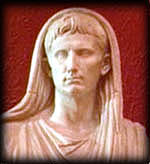 |
|
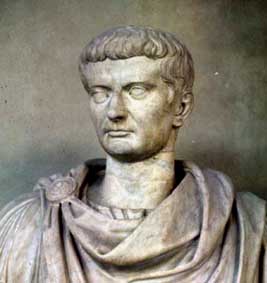 |
(2) [Timeline]
TIBERIUS
14-37
Punishes criticism of government:
encourages informants to denounce “traitors”. Initiates “police
state” and reign of terror.
|
|
|
(3) [Timeline]
CALIGULA
37-41
Demands that a statue of himself
be erected in the Temple in Jerusalem and accorded divine honors: dies
before the project is carried out.
|
|
|
(4) [Timeline]
CLAUDIUS
41-54
“Since
the Jews constantly made disturbances at the instigation of Chrestus, he
expelled them from Rome. . .”
|
|
“He
utterly abolished the cruel and inhuman religion of the Druids among the
Gauls, which under Augustus had merely been prohibited to Roman citizens;
on the other hand he even attempted to transfer the Eleusinian rites from
Attica to Rome, and had the temple of Venus Erycina in Sicily, which had
fallen to ruin through age, restored at the expense of the treasury of the
Roman people.”
Seutonius, Claudius, 25.
|
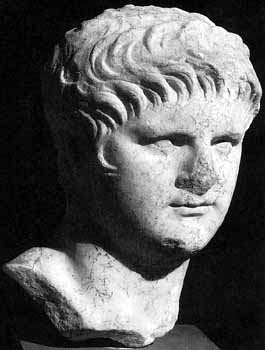 |
“ ...
Punishment
was inflicted on the Christians, a class of men given to a new and
mischievious superstition... ”
Suetonius, Nero 16 |
|
Tacitus, Annals xv. 44. But
all human efforts, all the lavish gifts of the emperor, and the
propitiations of the gods did not banish the sinister belief that the
conflagration was the result of an order. Consequently, to get rid of the
report, Nero fastened the guilt and inflicted the most exquisite tortures on
a class hated for their abominations, called Christians by the populace.
Christus, from whom the name had its origin, suffered the extreme penalty
during the reign of Tiberius at the hands of one of our procurators, Pontius
Pilatus, and a most mischievous superstition thus checked for the moment,
again broke out not only in Judaea, the first source of the evil, but even
in Rome, where all things hideous and shameful from every part of the world
find their centre and become popular.
Accordingly, an arrest was first made of all who pleaded guilty; then, upon their information, an immense multitude was convicted, not so much of the crime of firing the city, as of hatred against mankind. Mockery of every sort was added to their deaths. Covered with the skins of beasts, they were torn by dogs and perished, or were nailed to crosses, or were doomed to the flames and burnt, to serve as a nightly illumination when daylight had expired. Nero offered his gardens for the spectacle, and was exhibiting a show in the circus, while he mingled with the people in the dress of a charioteer or stood aloft on a car. Hence, even for criminals who deserve extreme and exemplary punishment, there arose a feeling of compassion; for it was not, as it seemed, for the public good, but to glut one man's cruelty, that they were being destroyed. |
|
|
(6) [Timeline]
VESPASIAN
69-79 Begins subjugation of rebellious Judea. |
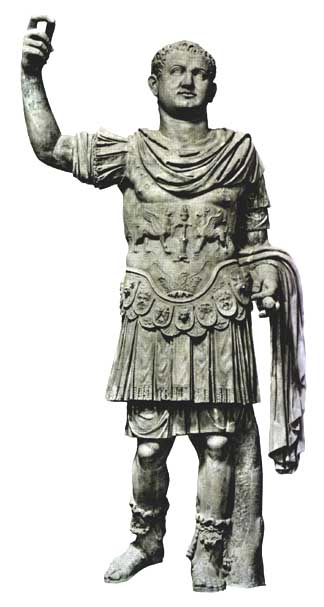 |
(7) [Timeline]
TITUS
- 79-81 Completes subjugation of Judea. Destroys Temple in Jerusalem |
|
|
(8) [Timeline]
DOMITIAN
81-96 Demanded the titles and honor of a god while still living. Revived the spies and informers of Tiberias' era. |
|
Suetonius,
Domitian 12.17.
Besides other taxes, that on the Jews was levied with the utmost rigor,
and those were prosecuted who without publicly acknowledging that faith
yet lived as Jews, as well as those who concealed their origin and did not
pay the tribute levied upon their people.
|
|
|
κἀν τῷ αὐτῷ ἔτει ἄλλους τε πολλοὺς καὶ τὸν Φλάουιον <τὸν> Κλήμεντα
ὑπατεύοντα, καίπερ ἀνεψιὸν ὄντα καὶ γυναῖκα καὶ αὐτὴν συγγενῆ ἑαυτοῦ
Φλαουίαν Δομιτίλλαν ἔχοντα,
67.14.2
κατέσφαξεν ὁ Δομιτιανός. ἐπηνέχθη δὲ ἀμφοῖν ἔγκλημα
ἀθεότητος,
ὑφ' ἧς καὶ ἄλλοι ἐς τὰ τῶνἸουδαίων
ἤθη
ἐξοκέλλοντες πολλοὶ κατεδικάσθησαν, καὶ οἱ μὲν ἀπέθανον, οἱ δὲ τῶν γοῦν
οὐσιῶν ἐστερήθησαν· 67.14.3 ἡ δὲ Δομιτίλλα ὑπερωρίσθη
μόνον ἐς Πανδατερίαν. |
Cassius Dio
Roman History Epitome of Book 67:14,1-3 Greek: Historiae Romanae : Cassii Dionis Cocceiani historiarum Romanarum (Weidmann, Berlin pyr 1895-190. rpr. 1955)
14
… “And
the same year Domitian slew, along with many others, Flavius Clemens the
consul, although he was a cousin and had as his wife Flavia Domitilla, who
was also a relative of the emperor's. The charge brought against them both
was that of atheism, a
charge on which many others who drifted into Jewish
ways were condemned. Some of these were put to death, and the rest
were at least deprived of their property. Domitilla was merely banished to
Pandateria.”
|
|
THE
ANTONINES
(THE “FIVE Good Emperors”) |
|
|
(9) [Timeline]
NERVA
96-98 Dio Cassius says Nerva forbade accusations of maiestas (treason) or of “Jewish practice” |
|
|
(10) [Timeline]
TRAJAN
98-117 Pliny correspondence: Christians to be executed if obstinate, freed if recant. Not to be sought out |
|
|
(11) [Timeline]
HADRIAN
117-138 Christians are to be executed if won't recant; but false informants to be dealt with harshly. |
|
Ἀδριανοῦ ὑπὲρ Χριστιανῶν ἐπιστολή.
|
Epistle of {H}Adrian on Behalf of the Christians. |
|
Μινουκίῳ Φουνδανῷ.
68.6Ἐπιστολὴν
ἐδεξάμην γραφεῖσάν μοι ἀπὸ Σερηνίου Γρανιανοῦ, λαμπροτάτου ἀνδρός, ὅντινα σὺ
διεδέξω. 68.7 οὐ δοκεῖ οὖν μοι τὸ πρᾶγμα ἀζήτητον καταλιπεῖν, ἵνα
μήτε οἱ ἄνθρωποι ταράττωνται καὶ τοῖς συκοφάνταις χορηγία κακουργίας
παρασχεθῇ.
|
I have received the letter addressed to me by your predecessor Serenius Granianus, a most illustrious man; and this communication I am unwilling to pass over in silence, lest innocent persons be disturbed, and occasion be given to the informers for practising villany. |
|
68.10
εἴ τις οὖν κατηγορεῖ καὶ δείκνυσί τι παρὰ τοὺς νόμους πράττοντας, οὕτως
διόριζε κατὰ τὴν δύναμιν τοῦ ἁμαρτήματος· ὡς μὰ τὸνἩρακλέα, εἴ τις
συκοφαντίας χάριν τοῦτο προτείνοι, διαλάμβανε ὑπὲρ τῆς δεινότητος, καὶ
φρόντιζε ὅπως ἂν ἐκδικήσειας.
|
If, therefore, any one makes the accusation, and furnishes proof that the said men do anything contrary to the laws, you shall adjudge punishments in proportion to the offences. And this, by Hercules; you shall give special heed to, that if any man shall, through mere calumny, bring an accusation against any of these persons, you shall award to him more severe punishments in proportion to his wickedness. |
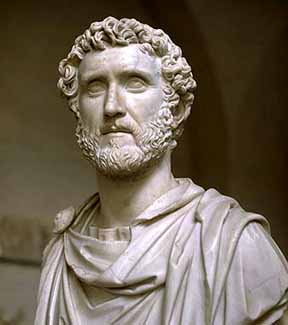 |
(12) [Timeline]
ANTONINUS
PIUS
138-161 |
|
|
(13)
MARCUS
AURELIUS
161-180 Authorizes amphitheater - torture by wild beasts for Christians in Gaul in 177 |
No comments:
Post a Comment